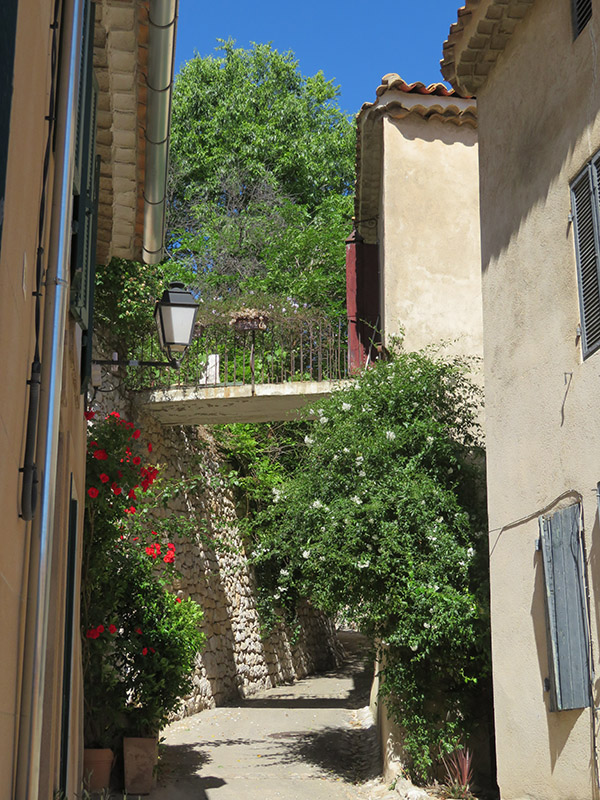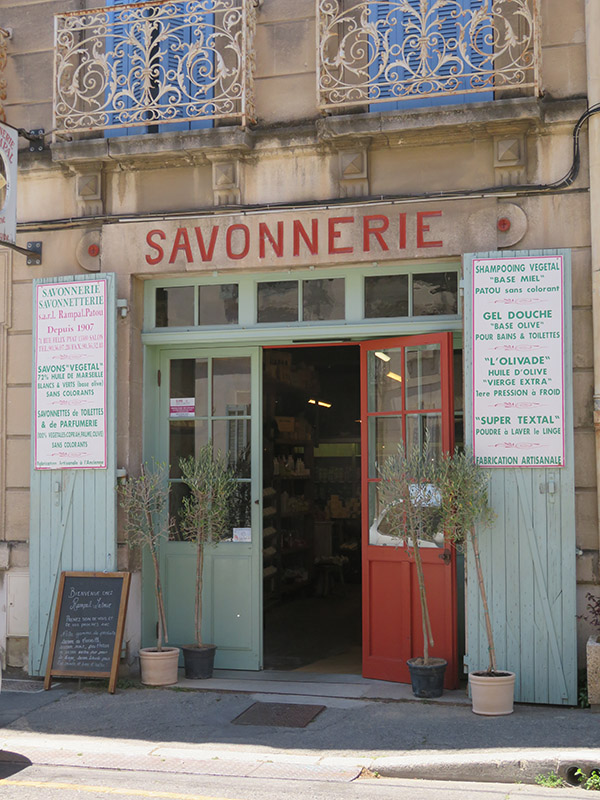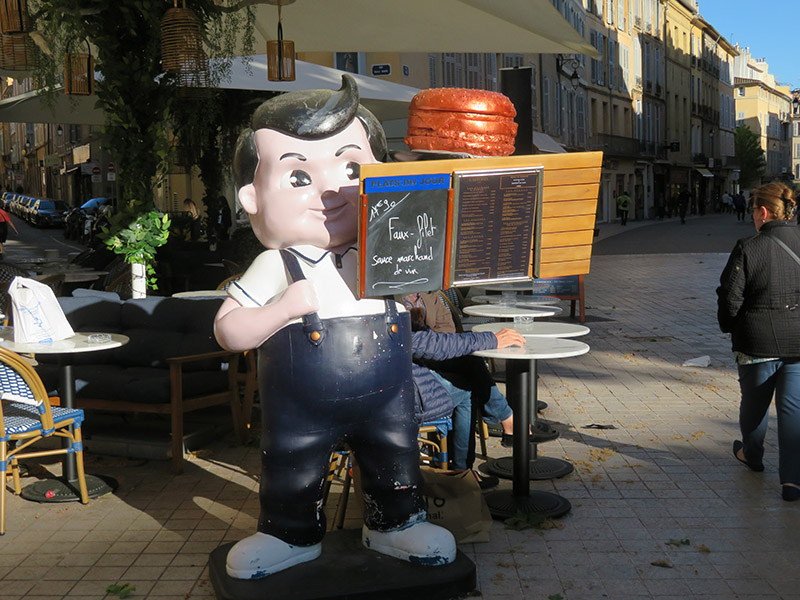 Wednesday morning, we decided to get the car and head out of town. Our apartment key chain included a remote to open the underground garage, which had a steep descent and a sharp curve, down to the car parked in a far tight corner. We made it out of the garage and then negotiated the narrow, crowded streets out of town, breathing a sigh of relief once we saw open fields. The sky was bright blue and the temperature in the mid-70s, but the Mistral wind was blowing strongly.
Wednesday morning, we decided to get the car and head out of town. Our apartment key chain included a remote to open the underground garage, which had a steep descent and a sharp curve, down to the car parked in a far tight corner. We made it out of the garage and then negotiated the narrow, crowded streets out of town, breathing a sigh of relief once we saw open fields. The sky was bright blue and the temperature in the mid-70s, but the Mistral wind was blowing strongly.
Our first stop was to visit a little-known gorgeous medieval hilltop village called Ventabren. It was built on a hillside during the 10th century to protect its citizens from Saracen raiders. We were able to park in a tiny lot part way up the hillside. Then we walked up narrow cobbled lanes lined with golden stone homes that had colorful but faded wooden shutters.
We came to a steep set of stairs that wound up past an olive orchard, and toward the top of the hill. At the crossroads of a path stood a statue of the Virgin Mary, who looked down at us. The path continued up to our right to the remains of a ruined castle, the Chateau de la Reine Jeanne (The Queen Jeanne castle). All that is left is one wall at the entry and another partial side wall, all surrounded by fence.
Queen Jeanne was born in 1326, the fourth child of Charles, the Duke of Calabria and Marie de Valois. She was said to be quite beautiful and powerful, but had a tragic life, having married four times. The first husband was murdered, the second died of the Bubonic plague, the third of illness or poison, and her fourth, Otto the Duke of Brunswick-Grubenhagen, survived her. While she lived, she became the Queen of Naples, and Countess of Provence and Forcalquier, for nearly forty years. She came to Provence to escape Hungarian troops invading Naples in 1348. But upon orders from her jealous cousin, she was imprisoned and assassinated in 1382.
 Next to the chateau was a cemetery, where the Mistral wind hissed and whooshed between the headstones. Had it been a dark night it would have been kind of spooky, but during the day with the bright sun, it was just atmospheric. There was a path that went all the way around the cemetery so we walked it to see the 360º view, which the hilltop offered. When we had completed the circling of the top of the hillside around the cemetery, we once again came to the statue of Mary. Now walking around her, we could see quite plainly that she was a pregnant Mary in her dark green iron dress. What we hadn’t noticed before was that she had her foot upon a serpent. Despite the white bird droppings on her, she was still impressive.
Next to the chateau was a cemetery, where the Mistral wind hissed and whooshed between the headstones. Had it been a dark night it would have been kind of spooky, but during the day with the bright sun, it was just atmospheric. There was a path that went all the way around the cemetery so we walked it to see the 360º view, which the hilltop offered. When we had completed the circling of the top of the hillside around the cemetery, we once again came to the statue of Mary. Now walking around her, we could see quite plainly that she was a pregnant Mary in her dark green iron dress. What we hadn’t noticed before was that she had her foot upon a serpent. Despite the white bird droppings on her, she was still impressive.
We found the reference in the Book of Genesis (3:15), of God warning the serpent after Adam and Eve had eaten of the fruit. “I will put enmities between thee and the woman, and thy seed and her seed: she shall crush thy head, and thou shalt lie in wait for her heel.” Initially this was interpreted by the Church to refer to Mary, the woman who would give birth to the Messiah. It would be through her action that Satan would be defeated, and Eve would be made pure.
 Back in the village there was a tiny museum in the tourist office, with just three glass cases, showing old bones and broken pots that had been discovered on the hillside. We were also surprised to see the sign for a modern restaurant called Dan B. A neighbor saw us and said it was a Michelin star restaurant and worth the visit.
Back in the village there was a tiny museum in the tourist office, with just three glass cases, showing old bones and broken pots that had been discovered on the hillside. We were also surprised to see the sign for a modern restaurant called Dan B. A neighbor saw us and said it was a Michelin star restaurant and worth the visit.
Our next stop was in Salon-de-Provence. This town was fortified in the 13th century, and still maintains its medieval layout. Now of course, the streets are modern, filled with cafes, retail shops, and wandering visitors, with several of its old gates open to pedestrians. We wanted lunch, so we found a small café and sat indoors away from the wind. We had fish and chips and warm goat cheese on toast with a salad. Then we found out that the places we had wanted to visit, the home of Nostradamus and the castle, were still closed for the season, which apparently didn’t open until May 13th, three days away.
However, the town had many lovely fountains. We found one completely covered in moss and ferns that provided a shady place to sit and enjoy the trickling of water.
 There was one destination that was open, an old savonnerie, or soap making factory.
There was one destination that was open, an old savonnerie, or soap making factory.
A small museum with its ancient tools was there, so we wandered and then bought a few things for personal use and gifts. On our way back and taking pictures of the town, we ended up stopping at one of the town’s sweet shops. We got some nougat and other small sweet items to enjoy on our trip. Then it was back to the car and back to Aix for a relaxing afternoon break.
For dinner, we ended up at a place nearby called L’Astoria. We had already passed it a couple times on our walks going back and forth to the garage. I was going right past it, because there was a Bob’s Big Boy plastic statue next to the outdoor menu and the last thing I wanted was American food, but after surveying the menu, Vere was drawn in. Bob’s checkered red and white overalls had been painted over with black paint. For U.S. citizens, France is one of their top destinations, so product recognition can draw that tourist in.
The mistral was still blowing so we went inside to eat. Vere ended up getting the chicken dinner with Roquefort sauce. They had a Caesar salad on the menu, but after my two less than tasty experiences with the salad, I shied away from having it. I finally decided on a small pizza with gruyere cheese, olives, and anchovies, which I love. But the waiter came back and said they did not have any anchovies. Did they have sardines? No. Any fish? No. Then Vere tried to joke with him, “not even cheddar gold fish?” No response. I still wanted pizza, could they add mushrooms? He said, how about the Margarita? Too plain, that’s not what I wanted. So he said he would bring me the Royal. I didn’t know what that was, as our menus had already been picked up. While waiting, a TV screen showed music videos from the 90s. When our food arrived, my pizza had plenty of tomato sauce, mushrooms, and olives, but it also had ham, which I don’t eat. So I just picked off the ham.



 The official website of Lita-Luise Chappell, writer on sex, magic, food, distant lands, and everyday life with articles, poetry, novels, travelogues, rituals, cookbooks, and short-stories.
The official website of Lita-Luise Chappell, writer on sex, magic, food, distant lands, and everyday life with articles, poetry, novels, travelogues, rituals, cookbooks, and short-stories.
